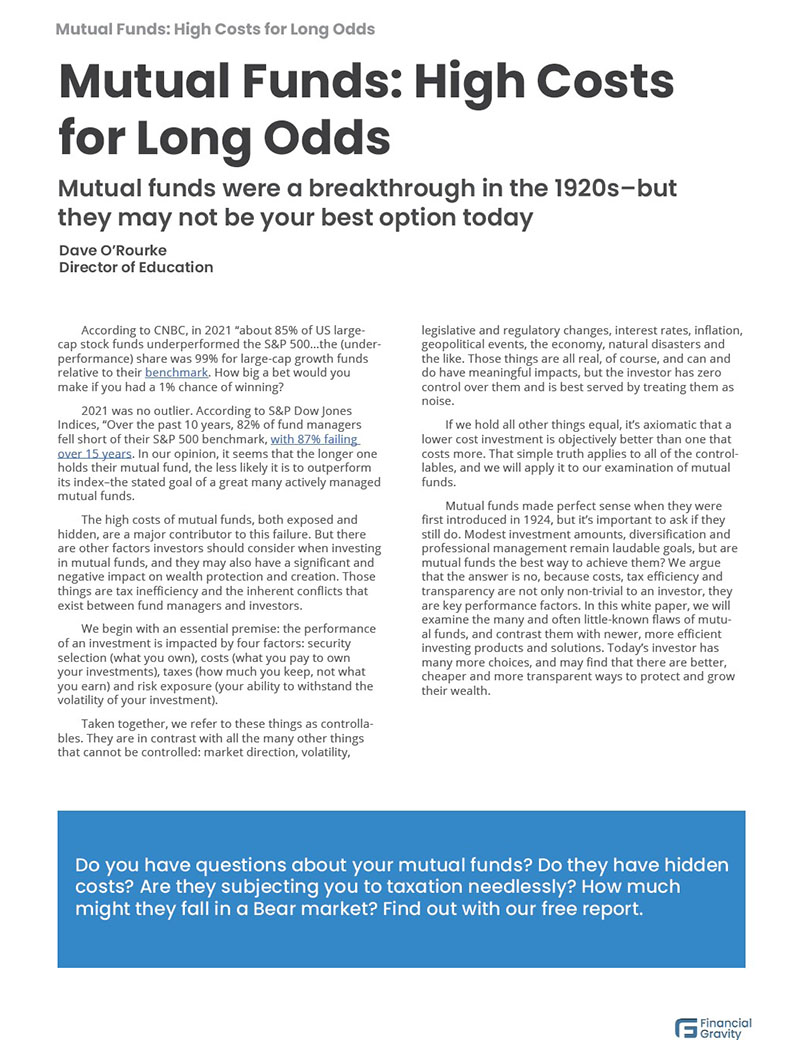As we wind down 2023 and begin to consider our choices in 2024, we find another confounding year for investors. There was troubling news on almost every front this year, yet the total return for the S&P 500 through November 6th was 15.25%. Could you have expected a solid year for stocks, given the financial situation? Probably not.
The Fed raised rates four times this year, totaling a full one percent, and the federal funds rate is now 5.25% to 5.5%. The last time the rate was as high as 5.5% was in January of 2001. Up to that date, interest rates had been in the range of 4.75% to 6% since August of 1994. After the peak in early 2001, the rate went down quickly and, with the exception of the mortgage boom from late 2005 to late 2007 (with a peak of 5.25%), stayed low until 2022. The rate actually hit zero in March of 2020, at the onset of the pandemic.
Fed action, which began well over three years ago, has been driven by persistently high inflation, notably in food and energy—two things no one can live without. There are signs that inflation may be calming down after a rough 2022, which saw an overall rise of 8% to the consumer price index (CPI), and 11.4% for food[1]. September’s CPI year-over-year increase was 3.6%[2].
Moderating inflation is obviously good news, but more than likely, today’s prices won’t be rolling back; the so-called ratchet effect in economics refers to the reality that prices move easily in one direction (up) but not the other (down). Beware falling prices: per Investopedia, “In an economy dominated by debt-fueled asset price bubbles, deflation can lead to a temporary financial crisis and a period of liquidation of speculative investment known as debt deflation.” There can be no doubt that the U.S. is debt-fueled.
Debt is everywhere. The gross federal debt is now over $33 trillion, which is equal to more than $100,000 per American. If only 59% of American households pay income tax, the debt per tax-paying household is nearly $170,000. According to the U.S. Census Bureau, state and local debt totals another $2.2 trillion[3]. Total U.S. household debt reached another $17 trillion in the second quarter of this year[4].
The CATO Institute has estimated that the U.S. government’s unfunded obligations, notably to Medicare and Social Security, total $79.5 trillion over the next 80 years[5]. Rising debt and deficits and higher interest rates are crowding out the government’s discretionary spending, which is now down to 27% of the total federal budget. Discretionary spending funds non-trivial things, such as defense, education, transportation, and veterans health care.
Our national economic challenges—inflation, high interest rates, ballooning debt—are not the only troubling news from 2023. There are now two active shooting wars that threaten the blood and treasure of America, and the constant threat from our global competitors, notably China. There is much to worry about, and yet, once again, the U.S. stock market has climbed that wall of worry to post another good year (at least as of this writing).
So, what is an investor to think or, more importantly, to do? What can you do differently in 2024 to become more financially secure? As we look back at a year of contradictions, what can we resolve to do about the coming year?
New Year’s Resolutions: Predictable Failure for Most
Making New Year’s resolutions is a popular American tradition. According to Motley Fool, 66% of Americans planned to make a financial New Year’s resolutions in 2023[6]], yet Forbes tells us that approximately 80% of New Year’s resolutions fail[7]. If you are among the group that plans to make one or more resolutions for 2024, and you’d like to see them succeed, we suggest you consider doing something different this time.
If you’re reading this, you have done a critically important thing: you’ve started your resolution process early. You have time to give the subject careful consideration and to understand why some resolutions succeed while most fail.
Loma Linda University School of Medicine has done research into something they call the States of Change Model. The model is known as “transtheoretical” and is focused on the decision-making process that leads to intentional change. It all sounds pretty academic and ethereal, but in reality, it’s a simple assessment of an individual’s readiness to change.
The first phase of the model is known as precontemplation, which is just a fancy word for denial. Resolutions are the result of the realization that the status quo isn’t working well. In the world of investing, this can be triggered by reviewing your investment statements and discovering that you are lagging behind the S&P 500, watching your savings account dwindle instead of growing, or even by an unexpected and unplanned expense.
Reading finance-themed newsletters is a good sign that you’re already past this first phase of change. Whether your motivation is the fear of an underfunded retirement or the prospect of working well past 65, or creating a legacy for loved ones, the good news is you’ve moved into the contemplative stage.
The contemplative stage can last for months, years, or, in some instances, for a lifetime. It is sometimes known as cognitive dissonance, a psychological tension between certain negative behaviors, like smoking, overeating, or even sunscreen use, and your thoughts and beliefs surrounding these behaviors. You know you should change but lack the motivation to do so.
If and when these negative behaviors cause you enough discomfort, you’ll enter the preparation phase. Finally, you’re ready to make some resolutions. You acknowledge that the pain of change outweighs the dangers of the status quo: the juice is worth the squeeze. You move to the next phase of change, action; you make your resolutions, and your body rewards you with a nice rush of dopamine, the “pleasure hormone.”
Unfortunately, this is where things can all fall apart, and not because you lack the will. What you may lack is the knowledge of how to effect the kind of change that matters. For example, you may resolve to pay down debt, build up an emergency fund, or trim your monthly spending. Those are laudable things, to be sure, but they will do little to move the needle on your lifestyle in retirement. They won’t compound your retirement account faster, they won’t address the really big risks in your life, like dying too soon or living too long, and they do nothing to address the overall impact of a nasty bear market or high inflation.
Resolutions That Work
Researchers have found that fewer than 10% of Americans who make New Year’s resolutions successfully complete them. About a quarter give up in the first week. This can be a problem if the goal is something hugely consequential, like your security in retirement.
For most people, solving for lifetime lifestyle security requires a disciplined investing program where savings compound over time. If that is your goal, consider making these strategic resolutions for 2024:
“I will eliminate all spending on financial services that does not directly lead to more wealth.”
“I will not overpay taxes on investment income and capital gains.”
“I will identify and diversify away all the risks and perils to my family.”
“I will determine exactly what my maximum downside risk exposure is and let that number guide my investment strategy.”
There is a huge benefit from approaching your resolutions in this way: you can achieve success quickly and permanently. You can be among that 9% of Americans who see their resolutions come to fruition. The financial resolutions you make in December of this year can be achieved by March of next year.
When combined with common sense, tactical commitments to paying down debt, rationalizing your spending, and building up a rainy day fund, you will have done all you can to create real security for you and your family.
We can’t do anything about inflation or any of the other downers from this year. But there’s a lot we can do to make 2024, and the years following, more positive by fixing the structural problems in your financial accounts.
This approach to making structural changes that will continuously improve your financial condition has another key benefit in that it eliminates the problem with instant gratification. If you’ve ever struggled with weight loss, you know the disappointment that comes from being hungry all the time but not seeing that reflected on your bathroom scale for weeks or months. Investing is like that: it takes years and years for wealth to compound. There’s an old saying, and it has a lot of truth in it: “You can’t save your way to prosperity.” You have to invest, not just save, and investing requires patience and discipline.
One other notable benefit that accrues from setting strategic goals is that they allow you to live in harmony with nature. You can control your costs, tax efficiency, risk management, and downside exposure, but that’s all you can do. There is nothing you can do about inflation, interest rates, the economy, or political events. There is a kind of anti-resolution you can set about all of that, and it can lead to happiness: resolve to treat non-controllables as noise.
These structural changes and the peace of mind that comes with letting go of non-controllables will make the maintenance phase of change a snap. You will be certain that you have done all you can reasonably do. You have prepared and acted, and you’re unlikely to relapse.
A great first step in planning for 2024 would be to understand exactly where you are now. Are you overspending on financial advice and solutions? Are you legally and ethically avoiding as much taxation as possible? Have you considered the risks you and your family face? Do you know what your maximum downside exposure is?
We can help you with the answers to all of these questions with a free report we call the Taxes First, Then Math analysis. The report will give you real insight into these key drivers of investing success, which can then turn into actionable resolutions.
Here’s to a healthy and happy Thanksgiving holiday.
Sources:
[1] oecd.org
[2] bls.gov
[3] justfacts.com
[4] newyorkfed.org
[5] cato.org
[6] fool.com
[7] forbes.com


